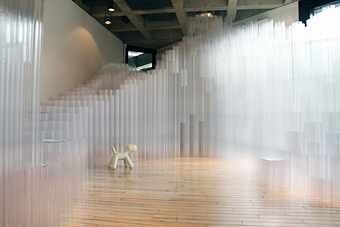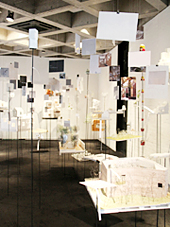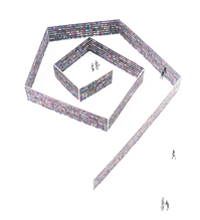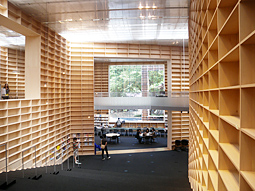 |
|
 |
left: Translucent polycarbonate cylinders suggest what future dwellings might be like if the conventional demarcations of floor, walls, and ceiling were relaxed. With flowing gradations reminiscent of a natural landscape, the cloud-inspired study is human-scale and cave-like, yet airy and pulsating with light.
right: Like a three-dimensional brain map, six dozen thought-clusters -- some suspended from the ceiling, others sprouting from the ground -- quiver and sway in the air currents of the gallery, relaying the conceptual processes that have informed and shaped Fujimoto's designs. |
In Forest, Cloud, Mountain -- Future Visions, a show running at Tokyo's Watari-um through January 16 2011, architect Sou Fujimoto reveals the creative thought process behind his unconventional designs, offering visitors of all professions inspiring insights to take away and apply to our own fields of endeavor.
Through a small yet steadily growing body of works, Fujimoto has established a reputation for unlikely designs that celebrate "the intuitive moment." His novel forms, minimalist in their treatment but complex in their geometry, win praise from fellow architects while laypeople applaud the inherent fun and immediacy of his spaces. And though his trademark themes -- our sensory experience of space, and the relationship of the built environment to the natural world -- stand at the very forefront of today's focus on the organic and experiential, this exhibition suggests that what's really behind the broad appeal of Fujimoto's approach is his deft handling of a few basic yet powerful strategies for imaginative thinking.
Seek hidden analogies. Think in metaphors. Ask offbeat questions. Bend the rules. Find inspiration in other fields. Observe patterns and cycles in nature . . . Fujimoto wields a trusty kit of creative-thinking tools that any of us would do well to take down from the shelf, dust off, and tinker with from time to time. The overriding message he sends is that truth is all around us -- what matters is where we place our focus.
Beginning with the premise that architecture is all about the provision of comfortable, functional, nurturing spaces, Fujimoto makes full use of Watari-um's three floors to question where the practice might head in an increasingly complex world. He draws on disparate concepts from nature -- the forest, cloud, and mountain themes of the exhibition title as well as caves, nests, and deserts, for example -- to flesh out his ideas. What if our dwellings were more like clouds -- what positive attributes would they have? What can a forest of trees tell us about inspired urban planning? What lessons about our relationship to the physical world does a mountain have to offer? Why is a cave more attractive than a nest?
From a luminous full-scale model on the second floor that explores the dwelling/cloud analogy, visitors move to the third floor exhibit -- a veritable celebration of free association. Here, a tiny pile of leaves invites us to consider architecture from an insect's perspective; there, an ammonite fossil shows the inspiration for the recently completed library at Musashino Art University. A display of haphazardly cut pieces of sponge asks what possibilities we see therein; a pile of well-worn books by the likes of George Gamow, Jorge Luis Borges, Michel Foucault and Le Corbusier quietly sings the praises of parallel thinking. Nearby, a colorful mass of mysterious sticky blobs exhorts us to produce something, anything -- and assign it some real value later. Clearly the spiritual heart of the exhibition, this playful presentation is akin to a three-dimensional blog, a physical extension of the acrobatic minds at work in Fujimoto's studio.
The exhibition ends on the fourth floor, where a 1:150 scale model of central Tokyo as it might appear in the future fills the main gallery. Architectural complexes rise up from the earth like a mountain or sway above the streets like so many trees. But the display is intended only as a starting point: in true Fujimoto style, sketching sheets are provided for visitors to create and leave behind their own visions of the city ten, fifty, or a hundred years from now. Presented in a thick binder, they are a living dialogue between the architect and the rest of us, enriching the creative soup.
 |
A number of events are scheduled in October in connection with the exhibition, including talks by pop culture critic Hiroki Azuma, architect Toyo Ito, multimedia designer Yugo Nakamura, and architect Kazuyo Sejima. For details, contact the museum or visit here (event information is in Japanese only).
 |
|
 |
Inspired by an ammonite-like rough sketch, the spirally configured bookshelves of the library at Musashino Art University are at once structural walls, partitioning walls, bridge supports, signposts, and an eye-pleasing conceptual articulation that dynamically links inside and outside.
Conceptual sketch © Sou Fujimoto Architects; photos © Susan Rogers Chikuba
Exhibition photos by permission of Watari-um
|
 |
|
 |
Tokyo Apartment, built in a quiet residential area near Ikebukuro, brings archetypal forms together in a chaotic, intriguing whole -- like the city itself.
Model © Sou Fujimoto Architects; photo © Susan Rogers Chikuba
|
|